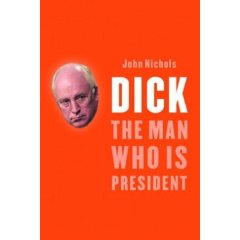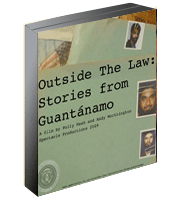Dick Cheney: invisible tyrant
26.6.07
 For the background on Dick Cheney’s rise to power, I recommend John Nichols’ Dick: The Man Who Is President (New Press, 2004), published in paperback in 2005 as The Rise and Rise of Richard B. Cheney. This is a review that I wrote for the website Nth Position:
For the background on Dick Cheney’s rise to power, I recommend John Nichols’ Dick: The Man Who Is President (New Press, 2004), published in paperback in 2005 as The Rise and Rise of Richard B. Cheney. This is a review that I wrote for the website Nth Position:
The man at the heart of investigative reporter John Nichols’ powerful and disturbing portrait of the Vice-President of the United States –- a man here revealed as the true power behind George W. Bush’s façade; the CEO of the USA; the most powerful man in the world –- is, astonishingly, almost invisible. Despite having a CV that apparently explains his rise to power –- as an aide to three presidents, the youngest ever White House chief of staff, the second most powerful Republican in the House of Representatives, a cabinet secretary and the CEO of a giant corporation –- Dick Cheney is a “shadowy Zelig figure” with a “Wizard of Oz-like penchant for remaining behind the curtains of authority”. In his introduction, helpfully entitled “The evil genius in the corner”, Nichols reveals that Cheney’s pursuit of anonymity has been so unrelenting that Secret Service officials used to call him “Backseat”.
“Backseat” launched his political career inauspiciously, “holding the button bag” for the governor of Wisconsin while the civil rights movement raged, and while his contemporaries were occupying student campuses. His early life was undistinguished. He dropped out of Yale, ran up a few drink-driving offenses, and strenuously avoided the Vietnam draft, deferring it on four occasions. Nichols notes, acidly, that his first child was born “Precisely nine months and two days after Selective Service eliminated special protections [from the draft] for childless married men”.
Handing out badges for a state governor may have been a humble start, but it was sufficient to get Cheney to Washington, working for moderate Republican senator Bill Steiger. He then met rising star Donald Rumsfeld, who so impressed Richard Nixon that the President soon employed him as a counselor in the White Horse. Cheney got to go along too, and Nichols points out that he immediately began studying Nixon’s tactics. He was already planning for the distant future, admiring in particular the President’s “moves to make the executive branch the dominant player in the federal government”.
Just before Watergate, Cheney got lucky again. Rumsfeld –- now suspected of being “slimy” and of having “liberal” tendencies –- was transferred to NATO, and Cheney took a job with a firm advising investment banks. As neither was implicated in the fallout from the Watergate scandal, they were soon back in the White House, this time working for Gerald Ford, with Rumsfeld as chief of staff and Cheney as his deputy. Together the two men removed obstacles to power. Robert Hartman, a moderate who was close to the President –- and who correctly identified them as “the little Praetorians” –- was sidelined, Henry Kissinger was demoted, and when they managed to obtain the resignation of defense secretary James Schlesinger, Rumsfeld took over his job and Cheney –- by default –- became the youngest ever White House chief of staff.
One of his occasional disasters followed. As the man directly responsible for the electoral campaign that failed to get Ford re-elected, he should have been damaged goods politically, but with his cloak of invisibility intact he simply retreated back to Wyoming –- his bolt-hole on the few occasions when his rise to power was temporarily put on hold –- where he duly resurfaced a few year later as a Congressman.
Cheney’s time in the House of Representatives revealed his political instincts to be as rabidly reactionary as ever. In his ten years in Congress, he was consistently one of the House’s most right-wing members. He voted against the Endangered Species Act, the Clean Water Act and the Clean Air Act. He voted against nutrition programs for children, against the Equal Rights Amendment and against a call for the release of Nelson Mandela. Nichols talked to Mandela, who recalled that “when the notoriously secretive and closeted Dick Cheney was forced to record his true sentiments, he stood consistently on the side of the most reactionary, racist and repulsive forces on the planet”, an opinion echoed by Robert Hartman, who commented that “whenever his private ideology was exposed, he appeared somewhat to the right of Ford, Rumsfeld, or, for that matter, Genghis Khan”.
Despite his voting record, Cheney has only once –- after his nomination as vice-presidential candidate in 2000 –- been called to account for his right-wing tendencies. Nichols blames the media, suggesting that the widespread ignorance regarding Cheney’s ideological extremism is “ample evidence of the collapse of serious journalism in the United States”, although it’s also clear that the illusion that Cheney managed to project shielded him from the critical gaze of most of his fellow senators. Time and again the Dick Cheney that colleagues on both sides of the House recall was, in the words of an article in a Philadelphia newspaper, a “friendly, gentlemanly candidate”, and one, moreover, who was “not an ideologue”.
Protected by this widespread inability on the part of others to see beyond his cordial front, Cheney assiduously pursued his own interests. He took a seat on the committee responsible for mining and drilling issues, where he “began collecting substantial campaign donations from the oil and gas industries”. He also chaired the Policy Committee, doing boring but essential work in the most vital link between Congress and the White House, where, despite serving in the House of Representatives, he continued to prepare for future office by fighting “to undermine the ability of the legislative branch to hold the executive accountable”.
Cheney got lucky again when George Bush was elected, landing the job of defense secretary when the President’s first choice, John Tower, turned out to be an “unhinged alcoholic”. It was in this position that his ambitions finally began to be fulfilled. Nichols observes that, as the last defense secretary of the Cold War era, Cheney was “handed a unique opportunity to guide not just the US, but the world away from the brink of nuclear holocaust, away from excessive military spending that was bankrupting superpowers and client states alike, and away from the fear-mongering that had manipulated the peoples of the planet into seeing one another as threats rather than as neighbors”.
Cheney, of course, was not for peace. While Colin Powell talked of “running out of enemies”, Cheney saw them everywhere. And he not only wanted enemies; he wanted to profit from them too. He was one of the chief architects of the radical neo-conservative manifesto, the 1992 Defence Planning Guidance –- which later resurfaced as the Project for the New American Century –- in which it was stated that “In the Middle East and Southwest Asia, our overall objective is to remain the predominant outside power in the region and preserve US and western access to the region’s oil”.
So it was that, in the face of demands for a “peace dividend”, Cheney managed to hold onto the defense budget. Although obliged to cut the numbers of soldiers to save costs, he arranged for the military’s logistical operations to be privatized, handing $210 billion to contractors whose CEOs were close friends. One of the chief beneficiaries of Cheney’s generosity with the public purse was Halliburton. Nichols points out that Cheney arranged for Brown and Root Services, a Halliburton subsidiary, to be paid $8.9 million to produce reports nominating itself to take over military operations, and in the years that followed the gravy train began to roll, delivering billions of dollars to Halliburton and other companies run by Cheney’s cronies. When Bush unexpectedly lost the presidential election to Bill Clinton, Cheney simply moved to Halliburton, where, in his five years as CEO, he collected a salary totalling $44 million, while Halliburton continued to cash in on the reforms that he himself had pushed through Congress, receiving contracts from the Clinton administration totaling $2.2 billion for operations in the Balkans, and even $109 million for the disastrous campaign in Somalia.
The last stage in this extraordinary story begins with the complex and patient maneuvering that led to Cheney’s nomination as vice-presidential candidate. He insinuated himself into the heart of the Bush family as early as 1995, when George W. Bush became governor of Texas, and he was on hand when the plan to groom him as a presidential candidate first emerged. As Bush Junior’s ineptitude first became apparent –- Nichols quotes a memorable interview in which he was unable to name the leaders of Pakistan, India, Taiwan and Chechnya –- Cheney was the man that Bush Senior approached to find a suitable vice-presidential candidate to be “in charge of the kid’s government”. Typically, Cheney whittled away at the prospective candidates, finding fault with all of them, until finally, as he had planned all along, George W. Bush was astonished to discover that “the best candidate might be sitting next to me”.
Since coming to power Cheney’s commitment to his agenda has been unwavering. As soon as victory was confirmed, he rented an office in Washington and began drafting policies and securing top-ranking positions for his long-standing allies. Rumsfeld went to defense, and other neo-conservatives were drafted into positions of power and authority: Paul Wolfowitz in the Pentagon, John Bolton as an undersecretary of state, and John Ashcroft as the attorney general. Blatantly disregarding any potential conflicts of interest, Cheney headed the National Energy Policy Development Group, appointing all 63 members, all of whom came from industry, and pushed through a new energy policy that proposed to open the Arctic National Wildlife Refuge for oil drilling, to build 1,300 new coal-fired power plants, to provide $33 billion in subsidies and tax cuts to encourage increased nuclear, oil and coal production, and to lay 18,000 miles of fuel pipeline “across what remained of the American wilderness”.
Companies in which Cheney is a board member –- including Morgan Stanley, Lockheed Martin and Procter and Gamble –- have all benefited from his new position, as have generous donors to the Republican cause –- including super-corrupt energy giant Enron –- and he continues to hold stock options in Halliburton that are worth over $10 million, and every year since 2000 has received “deferred salary payments” that are almost the same as his “official” salary as VP. Moreover, the market he created has continued to grow. In 2002, it was worth $150 billion to outside contractors, and in 2003, after the Vice-President managed to secure $87 billion “to maintain the occupation of Iraq and other military adventures abroad”, Halliburton’s contracts in Iraq alone were worth $11 billion.
Regime change in Iraq –- for oil, money and power –- was something that Cheney had first proposed to George Bush Senior during the 1991 Gulf War –- when it was turned down –- but it was an idea that he clung to over the following years. The events of September 11, 2001 finally allowed him to reinstate his violent dream, even though, as Nichols comments, “It was going to be a tough connection to make. Osama bin Laden and his followers hated Saddam Hussein, a secularist whose government included Christians and women, and Saddam feared the fanatical religionists as he did all movements that might organize opposition to his oppressive regime”.
Undeterred, Cheney insisted, with monotonous regularity, that Saddam had “a long-standing relationship with various terrorist groups, including the al-Qaeda organization”, that he had reconstituted chemical weapons programs, and that he was trying to produce nuclear weapons. He also insisted that Iraq had been involved in the 1993 bombing of the World Trade Center, and that suicide pilot Mohammed Atta had met an Iraqi intelligence agent in Prague. When no evidence whatsoever emerged to support any of Cheney’s claims –- even after his regular and unprecedented visits to the CIA, where he was known to demand, “Why doesn’t your intelligence support what we know is out there?” –- he turned to an “independent intelligence unit” that Rumsfeld had conveniently established in the Pentagon, where the spurious case for war was safe from dissenting voices.
If there was any doubt left that Cheney was the power behind the throne, this should have been demolished when he emerged briefly from the shadows –- as he had for a whole week in the immediate aftermath of 9/11 –- to run things personally. On this occasion he appeared on live TV in March 2003 to make the official case for war, running through the conspiracy theories and assuring the American public that the Iraqi people would “welcome us as liberators”. And if even this was not enough, final confirmation was provided by Paul O’Neill, a Cheney appointee to the Treasury who had resigned in disgust. O’Neill found a White House in which Cheney –- the leader –- had embraced “brazen ideology” that was “not penetrable by facts”, while Bush –- sidelined and stupefied –- was “like a blind man in a room of deaf people”.
This is a book that I’d urge anyone vaguely interested in the baleful powers that shape the modern world to buy. It is, as Studs Terkel has commented, “A farce noir, lethally funny. A revelatory work”. What Nichols can’t explain, of course, is what happened to shape a mild-mannered young man called Dick Cheney into a power-crazed fanatic. Significantly, the only poignant moments in the entire book are when Nichols describes Cheney’s parents. Both were staunch Democrats, and his father, who worked for the Soil Conservation Service, followed the visionary lead of its founder, Hugh Hammond Bennett, who declared that “no man should have the right, legally or otherwise, to recklessly or wilfully destroy or unnecessarily waste any resources on which public welfare is dependent”.
What did Cheney think when, in 2000, his father pointedly told him, “you can’t take my vote for granted?”
What does Dick Cheney see when he looks in the mirror?
Andy Worthington is the author of The Guantánamo Files: The Stories of the 774 Detainees in America’s Illegal Prison (published by Pluto Press, distributed by Macmillan in the US, and available from Amazon — click on the following for the US and the UK). To receive new articles in your inbox, please subscribe to my RSS feed.












 Who's still at Guantánamo?
Who's still at Guantánamo?
